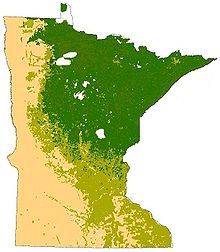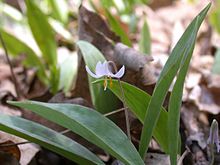Natural history of Minnesota

The natural history of Minnesota covers the plant and animal species of the
physiographic intersection of the Laurentian and the Interior Plains influences its plant and animal life. Three of North America's biomes converge in Minnesota: prairie grasslands in the southwestern and western parts of the state, the eastern temperate deciduous forests in the east-central and the southeast, and the coniferous forest
in the north-central and northeast.
Ecoregions
An
World Wildlife Fund maintain separate classifications of the state's ecoregions. Although different, they generally agree on delineating between the coniferous forest in the north-central portion and the Arrowhead, a temperate deciduous forest in the central and southeast, and the tallgrass prairie in the southern and western portions of the state.[1] The northern coniferous forests are a vast wilderness of pine and spruce trees mixed with patchy stands of birch and poplar
.
Flora

Much of Minnesota's northern forest has been logged, leaving only a few patches of old-growth forest today in areas such as in the Chippewa National Forest and the Superior National Forest where the Boundary Waters Canoe Area Wilderness has some 400,000 acres (1,600 km2) of unlogged land.[2] Although logging continues, regrowth keeps about one third of the state forested.[3]
Flora listed as threatened on the
United States Fish and Wildlife Service list of endangered species include the Prairie bush-clover (Lespedeza leptostachya), the Western Prairie Fringed Orchid (Platanthera praeclara), and Leedy's roseroot (Rhodiola integrifolia ssp. leedyi), and the Dwarf trout lily (Erythronium propullans).[4]
Fauna


Historic (and modern) loss of habitat, as well as overharvesting, has affected some native mammals to the point of
Whitetail deer and bobcats thrive; the state has the nation's largest population of wolves (specifically timber wolves) outside of Alaska,[9] and also supports healthy populations of black bears,[10] elk, Canada lynx, American martens,[11] fishers, and moose
.
Located on the
rabbits.[14] The number of snowy owls in the state in any given winter depends greatly on the winter conditions of the snowy owl's natural habitat, in areas such as Canada and Alaska
.
The state fish, the
References
- ^ "Biomes of Minnesota". Minnesota Department of Natural Resources. Retrieved 2009-08-16.
- ISBN 0-8166-2805-X.
- ISBN 1-56691-482-5.
- ^ "Listing and occurrences for Minnesota". Species Reports. United States Fish and Wildlife Service. November 30, 2010. Retrieved November 30, 2010.
- ISBN 0-87351-355-X.
- ^ "Bison".
- ^ "Cougars in Minnesota".
- ^ "NatureServe Explorer 2.0".
- ^ "Comprehensive Report Species - Canis lupus". Retrieved 2007-05-07.
- ^ Yang, Hannah (May 8, 2023). "Recent Minneapolis bear sighting is part of larger trend, experts say". MPR News. Retrieved 2023-05-09.
- ^ "American marten".
- ^ "Bald eagles in summer". Minnesota DNR. Retrieved 2021-01-07.
- ^ "Red-tailed Hawk". Minnesota DNR. Retrieved 2021-01-07.
- ^ Snowy owl, Minnesota Department of Natural Resources (2019).
- ^ "How to catch walleye, Minnesota's state fish". Minnesota DNR. Retrieved 2021-01-07.
- ^ "Fishes of Minnesota". Retrieved 2021-01-07.
